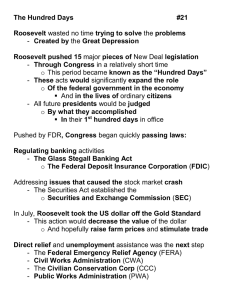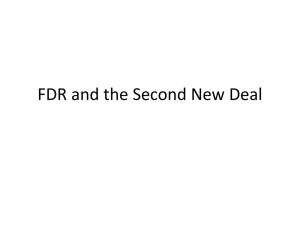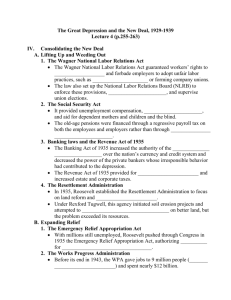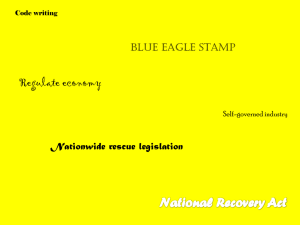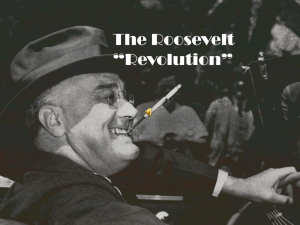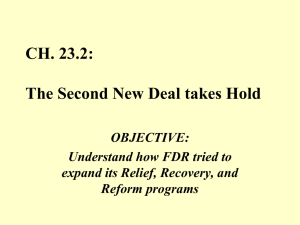Opening assignment - Bartlett High School
advertisement
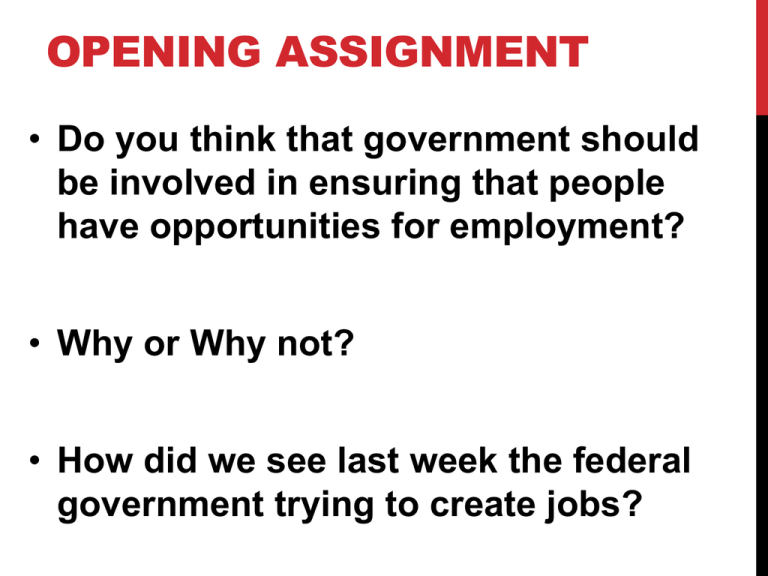
OPENING ASSIGNMENT • Do you think that government should be involved in ensuring that people have opportunities for employment? • Why or Why not? • How did we see last week the federal government trying to create jobs? Essential Learning Goal: • The hardship and suffering of the Great Depression led to an expansion of the federal government during the New Deal as Americans sought relief from their economic problems. Learning Targets: • I can recognize the Second New Deal’s efforts to extend further relief to Americans. • I can explain the importance of the Works Progress Administration (WPA) in helping put Americans to work. • I can organize New Deal policies into the three general categories; relief for the needy, economic recovery, and financial reform. THE SECOND NEW DEAL • By 1935, President Roosevelt was seeking ways to build on the programs established during the Hundred Days, his first 100 days in office in 1933. • The US economy had improved between 1933 and 1935, but progress was slower than the President had expected. • Unemployment was high, and production remained lower than the level of the 1920’s. • President Roosevelt called on Congress to provide more extensive relief for both farmers and workers. HELPING FARMERS • By the mid-1930’s, two of every five farms in the United States were mortgaged, and thousands of small farmers lost their farms. • What problem could this situation create for the US? • The US Supreme Court decided in 1936 that the Agricultural Adjustment Act was not legal because it said that farming was a local matter and should be regulated by the states rather than the federal government. • The President and Congress passed another law to replace the AAA: the Soil Conservation and Domestic Allotment Act. HELPING FARMERS • The Soil Conservation and Domestic Allotment Act paid farmers for cutting production of soil-depleting crops and rewarded farmers for practicing good soil conservation methods. 1. Why would soil conservation be a high priority for the government during this time period? 2. What continuing event was partially to blame for poor soil care? • In 1938 the Congress approved a second Agricultural Adjustment Act that brought back many features of the first AAA. • The second AAA did not include a processing tax for farm subsidies, a provision of the first AAA that the Supreme Court had declared unconstitutional. 1. What term is used to describe how the Supreme Court (Judicial Branch) reviews the laws and can stop the Congress when they pass laws that do extend beyond the federal government’s role? PUTTING MORE AMERICANS BACK TO WORK • The Works Progress Administration (WPA) set out to create as many jobs as possible, as quickly as possible. • Between 1935 and 1943 the WPA spend $11 billion to create more than 8 million jobs for mostly unskilled workers. • Some people criticized the WPA as a make-work project and that many of the jobs created were not needed. • The workers of the WPA built 850 airports, constructed or repaired 651,000 miles of roads, and put up more than 125,000 public buildings. • Women in sewing groups made 300 million pieces of clothing for the needy. 1. What do you believe is better paying Americans to do a job or giving them money through an unemployment check? IMPROVING LABOR CONDITIONS • During the Second New Deal President Roosevelt and the Congress brought about important reforms in the areas of labor relations and economic security for retired workers. • The Wagner Act established that joining a union and collective bargaining would be a right of the workers and protected by the government. • The Wagner Act also prohibited unfair labor practices such as threatening workers, firing union members for their membership, and interfering with union organizing. • The Act also created the National Labor Relations Board (NLRB) to hear cases of unfair practices and to hold elections to find out if workers wanted to have union representation. IMPROVING LABOR CONDITIONS • In 1938 the Congress passed the Fair Labor Standards Act, which set maximum hours at 44 hours per week, decreasing to 40 hours a week after two years. • The Fair Labor Standards Act also set a minimum wage at 25 cents an hour, increasing to 40 cents by 1945. • The Act also set rules for employment of workers under 16 years old and banned dangerous work for those under 18 years old. 1. Why might these rules restricting the jobs for those under 18 be put in place? 2. How might business owners view the Wagner Act as an unfair advantage to laborers and a burden upon the business? 3. Do workers need protection from their employers? THE SOCIAL SECURITY ACT • One of the most important achievements of the New Deal was creating the Social Security System. The Social Security Act of 1935 was created by a committee and had three major parts; • Old-age insurance for retirees 65 or older and their spouses. • Unemployment compensation system. • Aid to families with dependent children and the disabled. • Although the Social Security Act was not a total pension system and Americans needed to plan for additional retirement savings the system did provide substantial benefits to millions of Americans. 1. Consider that during this time period there were low wages and no retirement plans. How might this affect the living conditions for senior citizens? EXPANDING AND REGULATING UTILITIES • The Second New Deal also included laws to promote rural electrification and regulate public utilities. • In 1935, only 12.6% of American farms had electricity. The President used his executive order to create the Rural Electrification Administration (REA), which financed and worked with electrical cooperatives to bring electricity to isolated areas. • By 1945, 48% of America’s farms and rural homes had electricity. This number rose to 90% by 1949. DAILY REVIEW • On a piece of paper answer the following questions. 1. List 3 ways that the Second New Deal attempted to extend relief to Americans. 2. Explain why the Works Progress Administration was important in helping Americans. 3. Categorize the following New Deal policies into the three general categories; relief for the needy, economic recovery, or financial reform. • Minimum Wage, Social Security, Soil Conservation and Domestic Allotment Act, WPA, Wagner Act, and Rural Electrification Administration. HOMEWORK • Chapter 15 Section 2 • Read Pages 495 – 501 • Answer Main Idea Questions A – D • Complete the Skillbuilder #1 – 2 Page 497 • Define the Terms & Names into your notebook
